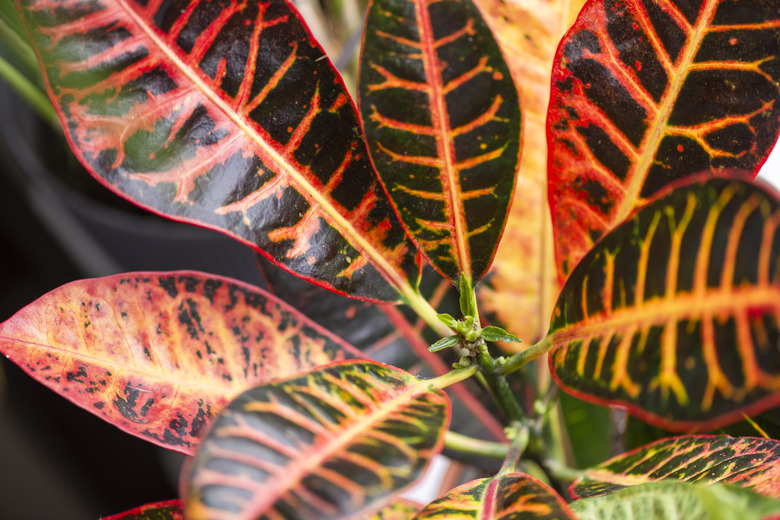Will Cutting Back A Croton Make It Sprout From The Bottom?
We may receive a commission on purchases made from links.
Crotons (Codiaeum variegatum) are tropical plants grown as houseplants in most of North America. The croton types feature a wide range of variegated foliage, from the yellow-spotted Gold Dust to the lush yellow-, orange-, red-, bronze-, and green-splashed Oakleaf. Hardy in U.S. Department of Agriculture plant hardiness zones 10b through 12, crotons are best trimmed in late spring and early summer when the plants are actively growing.
Tip
You can hard prune croton plants by up to one-third. However, there must be nodes or buds below the cut to produce new leaves and branches, or the plant will die.
About the Croton Types
About the Croton Types
Crotons were formerly classified as Croton variegatum, a member of the Croton plant family. Today, crotons have been separated into their own genus, which contains six species of these evergreen shrubs and small trees. All are part of the euphorbia family (Euphorbiaceae).
The crotons found in most nurseries and garden centers are Codiaeum variegatum, which feature brightly colored, leathery leaves and woody stems. The 2- to 18-inch-long leaves range from wide ovals to narrow blades in flat, wavy, or twisting shapes. Crotons grow up to 10 feet tall, but houseplants are usually kept smaller at 2 to 4 feet tall.
As with other euphorbias, always put on safety goggles, long sleeves, and gloves before working with or around the plants, as they weep a white milky sap. Sensitive individuals may experience skin irritation, a rash, or blisters from the sap. In addition, keep the plants out of the reach of children and pets, as the entire plant is toxic and will cause gastric distress if eaten. Always clean and sterilize cutting tools before trimming your plant.
Caring for a Croton
Caring for a Croton
While you can grow crotons in warm, frost-free climates, in most of North America, the plants can only enjoy a summer vacation in locations with morning sun, light, or dappled shade. It's a fine balance between plenty of light, which encourages the bright colors of the foliage, and too much sun, which bleaches out the color and leaves gray patches on the leaves. Indoors, put the plant in bright, filtered light or add a grow light to give it the exposure it needs to produce its colorful leaves.
When temperatures drop into the 60s, it's time to move the pots indoors for the winter. Keep the plant out of drafts produced by heating and cooling ducts. Water when the soil is dry to a depth of 1 inch or the plant begins to wilt. Add humidity to the air with a cool steam vaporizer, grouping multiple houseplants together and/or setting the pot on top of a water- and pebble-filled tray.
Fertilize in early spring, early summer, and mid to late summer with a slow release 3-1-2 or 8-2-10 fertilizer. Alternatively, feed indoor plants bimonthly with a liquid fertilizer diluted according to the package directions. Always water after fertilizing.
Cutting Back the Croton
Cutting Back the Croton
Crotons often drop some of their leaves when being moved from one location to another. Dead leaves and branches should be removed immediately all the way back to the stem. Trim overgrown branches and leaves back to a node or bud; the plant will produce new branches and leaves to replace them. Pinching croton plant stems regularly helps shape the plant and reduces the need for additional pruning.
You can remove up to one-third of the stem without harming the plant. Cut the stem just above a node or leaf bud to ensure the plant will grow new branches and foliage. The plant will not produce new shoots from the roots if you hard prune a croton. If you cut it back too far, it may not survive.
Starting New Plants
Starting New Plants
Use healthy 3- to 4-inch-long stems to propagate new croton plants. Remove the lower leaves and then allow the cut to scab over. Then, insert them into moist potting mix. Cover the stems and leaves with a large plastic bag supported by stakes. Place them in a warm, bright location and keep the potting mix moist until new growth appears. Then, repot them in a larger flowerpot.
References
- Missouri Botanical Garden: Codiaeum variegatum var. pictum
- Wisconsin Horticulture Division of Extension: Croton, Codiaeum variegatum
- North Carolina Extension Gardener Plant Toolbox: Codiaeum variegatum var. pictum
- International Euphorbia Society: About Euphorbiaceae Cultivation – Vegetative Propagation
